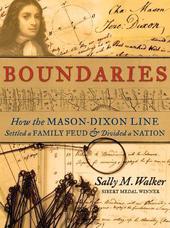
|
Boundaries: How the Mason-Dixon Line Settled a Family Feud and Divided a Nation
Hardback
Main Details
| Title |
Boundaries: How the Mason-Dixon Line Settled a Family Feud and Divided a Nation
|
| Authors and Contributors |
By (author) Sally M. Walker
|
| Physical Properties |
| Format:Hardback | | Pages:208 | | Dimensions(mm): Height 264,Width 203 |
|
| ISBN/Barcode |
9780763656126
|
| Classifications | Dewey:911.751 |
|---|
| Audience | |
|---|
|
Publishing Details |
| Publisher |
Candlewick Press,U.S.
|
| Imprint |
Candlewick Press,U.S.
|
| Publication Date |
11 March 2014 |
| Publication Country |
United States
|
Description
The Mason-Dixon Line's history, replete with property disputes, persecution, and ideological conflicts, traverses our country's history from its founding to today. We live in a world of boundaries - geographic, scientific, cultural, and religious. One of America's most enduring boundaries is the Mason-Dixon Line, most associated with the divide between the North and the South and the right to freedom for all people. Sibert Medal-winning author Sally M. Walker traces the tale of the Mason-Dixon Line through family feuds, brave exploration, scientific excellence, and the struggle to define a cohesive country. But above all, this remarkable story of surveying, marking, and respecting lines of demarcation will alert young history buffs to their guaranteed right and responsibility to explore, challenge, change, and defend the boundaries that define them.
Author Biography
Sally M. Walker is the Sibert Medal-winning author of Secrets of a Civil War Submarine as well as many other nonfiction books. She lives in Illinois.
Reviews[A] richly layered, thoroughly researched history of the Mason-Dixon Line.... Walker reveals a fascinating and complicated history of exploration, family feuds, persecution, ideological conflicts, scientific experimentation and advancement, and the forging of a national identity. ... A thoughtful, insightful, challenging and extensively researched chronicle of United States history and the shaping of national identity from a unique perspective. -Kirkus Reviews (starred review) Walker's account, supplemented with numerous illustrations and maps, of the conflicts along the disputed boundary and Mason and Dixon's innovative methods of scientific surveying is comprehensive and objective... Her emphasis on the survey provides a perspective missing in titles such as John C. Davenport's "The Mason-Dixon Line," which focuses on the line's political and military role in the antebellum slavery debate and Civil War and the postwar cultural division between North and South. ... [The topic's] importance in American history makes this book a strong report choice about the boundaries that shaped our nation or science in early America. -School Library Journal This thoroughly researched account of the Mason-Dixon Line encompasses a broad span of time and place, from sixteenth-century England to twentieth-century America. ... Walker's latest book offers a good deal of pertinent information on the subject at hand, as well as some interesting sidelights on American history. -Booklist A useful, informational text with strong science and math connections for middle and high school and public libraries. -VOYA In characteristic fashion, Walker delves deeply into her topic, providing meticulous detail not only about surveying but also about colonial-era sociopolitics. She ends with a discussion of the cultural relevance of the Mason-Dixon Line to the North and the South, and modern-day interest in the preservation of its history. ... The immersive story may inspire the next generation of geographers, cartographers, and astronomers. -The Horn Book Scientific and mathematical concepts are clearly presented and well-defined. -Publishers Weekly Many history books for youth gloss over science and math in favor of a strictly human-interest approach, but Walker embraces the fields and walks readers through both the theory behind the calculations and the exhausting (and expensive) fieldwork it took to get results. Plenty of maps and diagrams support the text, and even math-resistant readers may find themselves learning more than they expected. The most appreciative audience, though, will be the kids who doodle in their notebooks through history class, just waiting for the bell to ring for math. -Bulletin of the Center for Children's Books
|